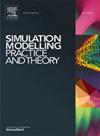A cellular automata model of a laser reproducing laser passive and active Q-Switching
IF 3.5
2区 计算机科学
Q2 COMPUTER SCIENCE, INTERDISCIPLINARY APPLICATIONS
引用次数: 0
Abstract
The Q-switching (QS) phenomenon in lasers refers to the production of high intensity pulses by means of a saturable absorber (passive method) or by modifying the reflectivity or losses of the intracavity optics or mirrors (active method). Theoretically, the QS is studied through the laser rate equations which are useful to predict, at least qualitatively and roughly, the fundamental aspects of laser dynamics. However, specific details such as the spatial distribution of the intensity of the laser emission escape the simplicity of the rate equations. In this work we present a two dimensional cellular automata model (CA) to study the QS phenomenology for both the passive and the active method. To simulate the passive method we consider a spatial distribution of cells whose physical properties emulate those of the saturable adsorbers. And for the active method we introduce a periodic modulation of the lifetime of the photons inside the cavity. We have done numerous numerical simulations that show that despite the simplicity of the evolution rules, the AC model is capable of obtaining the main dynamics of operation of the laser by modifying the system parameters such as the pumping probability and the properties of the absorber.
再现激光器无源和有源 Q 开关的细胞自动机模型
激光器中的 Q 开关(QS)现象是指通过可饱和吸收器(被动方法)或改变腔内光学器件或反射镜的反射率或损耗(主动方法)产生高强度脉冲。从理论上讲,QS 是通过激光速率方程进行研究的,这些方程至少可以定性和粗略地预测激光动力学的基本方面。然而,激光发射强度的空间分布等具体细节却无法摆脱速率方程的简单性。在这项工作中,我们提出了一个二维蜂窝自动机模型(CA),用于研究被动和主动方法的 QS 现象。为了模拟被动方法,我们考虑了细胞的空间分布,其物理特性模拟了可饱和吸附器的物理特性。而在主动方法中,我们引入了对空腔内光子寿命的周期性调制。我们进行了大量的数值模拟,结果表明,尽管演化规则很简单,但交流模型能够通过修改系统参数(如泵浦概率和吸收体的特性)获得激光器的主要运行动态。
本文章由计算机程序翻译,如有差异,请以英文原文为准。
求助全文
约1分钟内获得全文
求助全文
来源期刊

Simulation Modelling Practice and Theory
工程技术-计算机:跨学科应用
CiteScore
9.80
自引率
4.80%
发文量
142
审稿时长
21 days
期刊介绍:
The journal Simulation Modelling Practice and Theory provides a forum for original, high-quality papers dealing with any aspect of systems simulation and modelling.
The journal aims at being a reference and a powerful tool to all those professionally active and/or interested in the methods and applications of simulation. Submitted papers will be peer reviewed and must significantly contribute to modelling and simulation in general or use modelling and simulation in application areas.
Paper submission is solicited on:
• theoretical aspects of modelling and simulation including formal modelling, model-checking, random number generators, sensitivity analysis, variance reduction techniques, experimental design, meta-modelling, methods and algorithms for validation and verification, selection and comparison procedures etc.;
• methodology and application of modelling and simulation in any area, including computer systems, networks, real-time and embedded systems, mobile and intelligent agents, manufacturing and transportation systems, management, engineering, biomedical engineering, economics, ecology and environment, education, transaction handling, etc.;
• simulation languages and environments including those, specific to distributed computing, grid computing, high performance computers or computer networks, etc.;
• distributed and real-time simulation, simulation interoperability;
• tools for high performance computing simulation, including dedicated architectures and parallel computing.
 求助内容:
求助内容: 应助结果提醒方式:
应助结果提醒方式:


